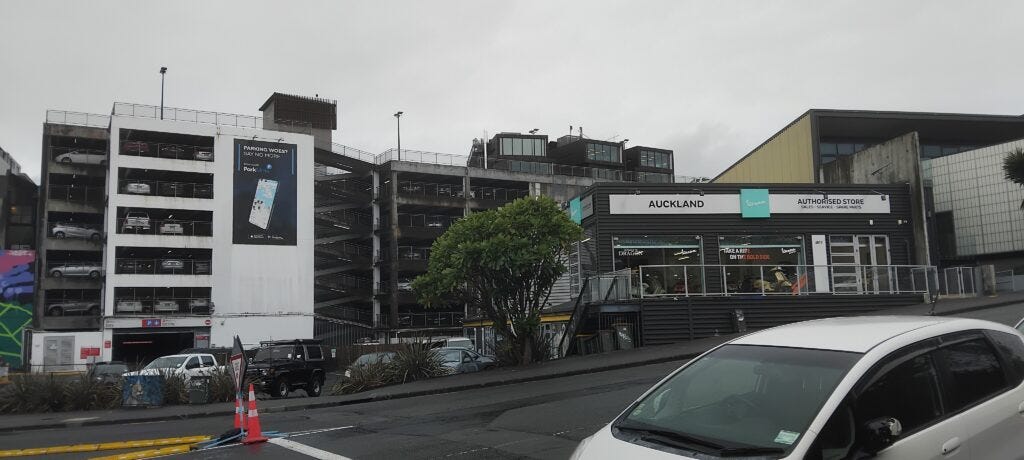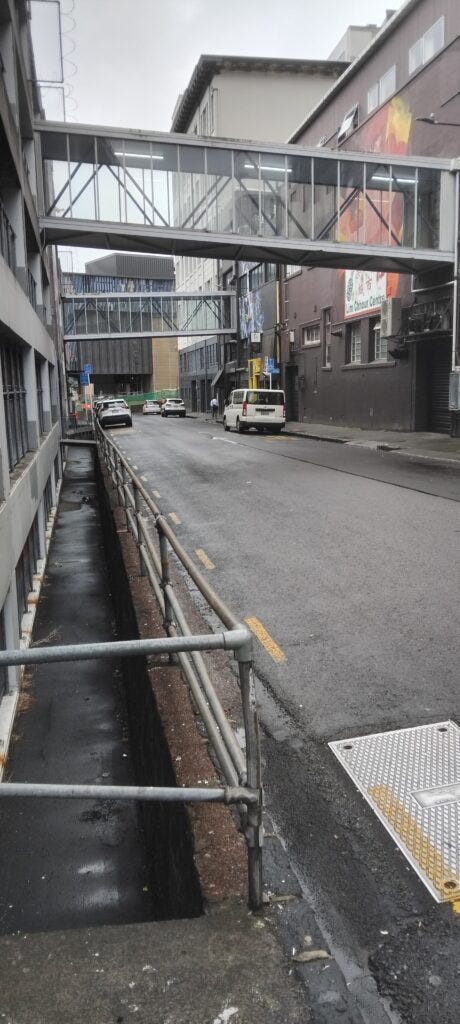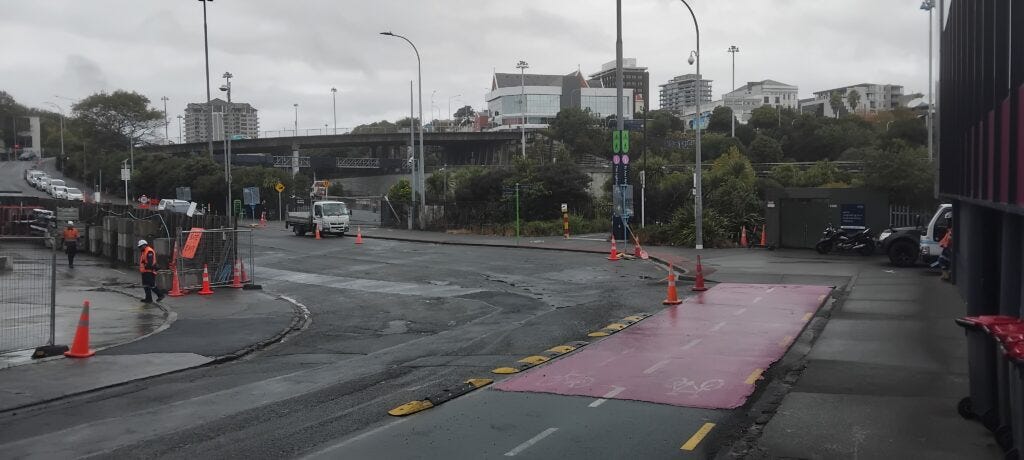A few weeks ago, I wrote a post extensively detailing the scandal of what happened with the Upper Mercury Lane part of the Karanga-a-Hape Station precinct integration project (also known by its cool title, Project K). It was a prime example of Auckland Transport's habitual failure to follow through on well-supported and widely-consulted projects that improve the status quo.
But I didn't want my post to be yet another "grumble about AT" – after all, we have our Mayor for that. Instead, I proposed a list of things AT's leadership could learn, in order to prevent this kind of failure from happening again and again. The lessons were:
Senior leadership needs to back their staff – and commit to progressing their mandate
Run the process with a firm hand – mitigations are fine, but destroying the core part of a project is not
Stand up to bullies from the vocal minority – even to court if you have to
Have the courage to speak up and communicate with the public – tell the story of why this project is happening
Stick to the plan, stick to the strategies, and stick to the timeline – DELIVER instead of DELAY
Disruption and turmoil is inevitable, and it’s also an opportunity to excel and go further – so do it once and do it well
You will be amazed (and I'm sure totally surprised) to hear that Auckland Transport has wasted no time in continuing to do exactly what they always do - undermine good projects
Yesterday, the Project K team gave an update on the project at a workshop with the Waitematā Local Board. Their presentation (from page 81) outlined a number of design changes to Project K – all of which prioritise road traffic over people, all of which are in opposition to the results of the public consultation on designs in 2023, and all of which are an absolute indictment of Auckland Transport's leadership.
This post, like all our work, is brought to you by the Greater Auckland crew and made possible by generous donations from our readers and fans. If you’d like to support our work, you can join our circle of supporters here, or support us on Substack!
Cross Street
Let's start on Cross Street, where Auckland Transport has decided to preserve on-street carparking, which means choosing not to expand the pedestrian zone. They're also removing from the design the promised raised tables and traffic-calming elements, the planter boxes, and the proposed separators and surface-level footpath buildout on the south side.
In other words, they're doing pretty much nothing to change the street and make it a suitable realm for what will be one of the busiest subway entrances in the city. The "Cross Street design" now essentially locks in the status quo. The only saving grace is these are no-dig works... but it still makes zero sense not to improve anything.
What is that status quo? Well, I took a walk yesterday and took some photos. It looks like this. Notice the giant carparking building?

Yep, this is clearly a very pleasant walking environment that needs no changes. Certainly it's great the south side of the street won't be getting improvements! It's a good thing the thousands of people drawn to the city by this $5.5 billion rail project will be shoved to the skinny footpath on the north side. Excellent planning.

Here's a couple of sketches for potential (and supported) footpath expansion from the 2023 community engagement workshops:
Right, so what else has AT suddenly changed in this well-consulted design?
East and Canada Street
On both East Street and Canada Street, Auckland Transport plans to return two-way vehicle traffic... by deleting the cycleway between the Lightpath and South Street. And by removing/ shrinking proposed planter islands.
Currently, East St looks like this. But Auckland Transport is choosing to remove the interim stretch of cycleway (past one of the city's busiest bike shops) to replace it with a traffic lane, and NOT a proper cycleway, as was consulted on.
Worse, as you'll note from the fine print above, the cycleway is being replaced with the dreaded "sharrows", to indicate "shared use of the road by motorists and cyclists." How on earth did that make it through a safety audit, or past expert quality control for cycling facilities? Did it make it through a safety audit, or expert quality control for cycling facilities?

But wait, there's more! On Canada Street, Auckland Transport is removing planned pedestrian space ("a reduction in the green area", including potential tree removal) to make way for... a roundabout, to manage the two-way traffic. Note the lack of safe crossings on two of the roundabout approaches, as well.
I appreciate there may have been a need for adjustments to the plans for this part of the project, but these are not small adjustments. This is a major reset of priorities, with impacts on safety and access for what will – I repeat – become one of the busiest foot-traffic areas in the city from day one of the CRL opening (which is a $5.5 billion project).
Design whiplash: compare the way Auckland Transport described the plans in 2023 and 2024
Something I want to make very clear is, Auckland Transport had a good project and were doing the right thing.
In consultation, public feedback supported the original project, its aims and its design principles. The feedback report indicated that those concerned with vehicle access (i.e. parking and loading) mostly just wanted some options for loading areas and passenger drop-off. But somehow, in the space of a few short years, this knowledge has been lost.
If you go back to July 2024 (thanks to the Wayback machine) this is what the project webpage, said regarding Cycleways, Pedestrian Spaces, and Parking and Loading:
People supported the original plans! This bears repeating: up until 2024, Auckland Transport had a good project that people supported. And then they changed it. Why? Who? And for what reasons?
This is a disgraceful switcheroo
The Project K that's being built should be the one that was publicly consulted on in 2023.
Yes, there were small kinks to work out. Yes, some adjustments could be made on loading zones, access etc.
But nothing justifies these significant changes, on this scale. Nothing justifies steamrolling over space for people walking and cycling to create more space for vehicles. And nothing was in the public-facing consultations about this.
City Rail Link is the biggest infrastructure project in this country's history, a $5.5 billion investment. It's at the heart of a reimagined city with an improving public realm, wide and welcoming footpaths, and an increasingly connected bike network. Tens of thousands of people live in the central city and tens of thousands more will move through this area each and every day, on foot and on bikes.
How on earth does reducing the transformation of the area around the stations maximise this value?
Remember, the overarching vision for the City Centre is the City Centre Master Plan, which is supposed to guide Auckland Council and the CCOs. This is Transformational Move 5:
Access to Auckland city centre is being transformed by regional public transport investment, including City Rail Link, the new bus network, ferries and proposed light rail. A better environment for walking, cycling and micro-mobility will increase connectivity within the centre. Thousands more Aucklanders will have increasingly easy access to the city centre and city fringe via public transport. The city centre's role as a regional transport interchange will also become stronger. This move will shape planning and development in the best-connected areas of Auckland, maximising the benefits of investment in public transport and associated public realm.
How exactly does the gutting of Project K create a "better environment for walking, cycling and micro-mobility", that maximises "the benefits of investment in public transport and associated public realm"?
Consider too the transport part of the Master Plan – Access for Everyone, which aims to remove through-traffic from city centre neighbourhoods.
How does the gutting of Project K, by removing pedestrian streets and bringing back vehicle access, align with that?
What about the Transport Emissions Reduction Pathway (TERP), the only pathway for Auckland to reduce its transport emissions.
How does removing cycleways and pedestrian space to allow for two-way vehicle access 'supercharge walking and cycling'?
What about Vision Zero, the overriding safety aim of Auckland Transport.
How does removing raised crossings and other safety measures achieve Vision Zero?
Did I mention already this is the complementary street upgrade to a game-changing $5.5 billion public transport project?
This change of plan is a complete indictment on the leadership of this organisation. It's an inexplicable refusal to change the status quo, in spite of political and public support, in spite of funding, and regardless of common sense.
While this is only one project, we see, ad nauseam, this same walking back, reducing, removing, and undermining good projects and plans. I want to highlight what the TERP said in 2022, highlighting the risk of recalcitrance in organisations like Auckland Transport.
Organisational conservatism. All the agencies involved in Auckland’s transport system have strategies stating the importance of reducing transport emissions. However, this strategic intent is not always reflected in their investment priorities, detailed project implementation or their supporting policies. There are several reasons for this including:
objectives that are often poorly defined and not prioritised
legislative mandates that do not explicitly cite emission reduction as a key objective
organisational structures and processes that reinforce the status quo or deliver only incremental change
entrenched ways of working amongst transport and land use planning professionals
political, stakeholder and public pressure that often makes change on the ground difficult.
Agencies are therefore incentivised to maintain the existing transport system which tends to be reflected in risk averse cultures and thinking that fails to adequately account for climate change impacts and adaptation costs.
Project K is a prime, glaring, high-profile example. And as with last time, it's almost certainly not the project team who made the call – they've been at the front lines of design and consultation, and know what people want and need. But they've been sent out to front yet another grand retreat.
Now we can so clearly see this problem, can we fix it? Because if a $5.5 billion project is not enough to overcome the organisational conservatism of Auckland Transport, what will?
We reached out to AT with a fair few questions about these changes, you can find their response here in our weekly roundup.



















Thanks Connor for the update. It's utterly unexplainable in my mind. It will be a sad precinct compared to what it could have been.